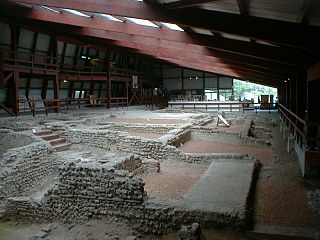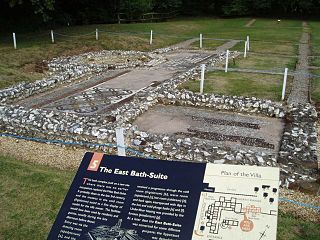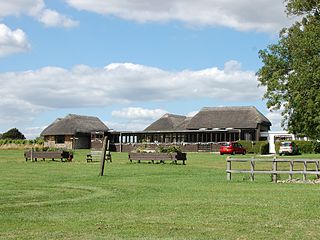Related Research Articles

Lullingstone Roman Villa is a villa built during the Roman occupation of Britain, situated in Lullingstone near the village of Eynsford in Kent, south-eastern England. The villa is located in the Darent Valley, along with six others, including those at Crofton, Crayford and Dartford. Constructed in the 1st century, perhaps around 80–90 AD, the house was repeatedly expanded and occupied until it was destroyed by fire in the 4th or 5th century. The villa was occupied over various periods within the Romano-British period, but after its destruction, it is only thought to have been reoccupied during the medieval period. The occupants were most likely wealthy Romans or native Britons who had adopted Roman customs.
The year 1971 in archaeology involved some significant events.

The Villa Romana del Casale is a large and elaborate Roman villa or palace located about 3 km from the town of Piazza Armerina, Sicily. Excavations have revealed Roman mosaics which, according to the Grove Dictionary of Art, are the richest, largest and most varied collection that remains, for which the site was designated as a UNESCO World Heritage Site in 1997. The villa and its artwork date to the early 4th century AD.

Venta Silurum was a town in Roman Britain (Britannia). The name Venta Silurum means "the town of the Silurēs", with the Silurēs being a powerful and warlike tribe. Today, it consists of remains in the village of Caerwent in Monmouthshire, southeast Wales. Much of it has been archaeologically excavated and the nearby Newport Museum has many of the finds on display.
The year 1819 in archaeology involved some significant events.

Roman Carthage was an important city in ancient Rome, located in modern-day Tunisia. Approximately 100 years after the destruction of Punic Carthage in 146 BC, a new city of the same name was built on the same land by the Romans in the period from 49 to 44 BC. By the 3rd century, Carthage had developed into one of the largest cities of the Roman Empire, with a population of several hundred thousand. It was the center of the Roman province of Africa, which was a major breadbasket of the empire. Carthage briefly became the capital of a usurper, Domitius Alexander, in 308–311. Conquered by the Vandals in 439, Carthage served as the capital of the Vandal Kingdom for a century. Re-conquered by the Eastern Roman Empire in 533–534, it continued to serve as an Eastern Roman regional center, as the seat of the praetorian prefecture of Africa.

Gadebridge Roman Villa, alternatively known as Gadebridge Park Roman Villa, is a ruined Roman villa in Hemel Hempstead, Hertfordshire, England.

Rockbourne Roman Villa is a Roman courtyard villa excavated and put on public display in the village of Rockbourne in the English county of Hampshire. The villa was discovered in 1942 by a local farmer and excavated by A. T. Morley Hewitt over the next thirty years.

Bignor Roman Villa is a large Roman courtyard villa which has been excavated and put on public display on the Bignor estate in the English county of West Sussex. It is well known for its high quality mosaic floors, which are some of the most complete and intricate in the country. It is managed by the Bignor Roman Villa Charitable Trust, a registered charity.

Brading Roman Villa was a Roman courtyard villa which has been excavated and put on public display in Brading on the Isle of Wight.
The Llantwit Major Roman Villa was a Roman L-shaped courtyard villa located at what is now Caermead, immediately north of the town of Llantwit Major in the Welsh county of South Glamorgan.

Villa Boscoreale is a name given to any of several Roman villas discovered in the district of Boscoreale, Italy. They were all buried and preserved by the eruption of Mount Vesuvius in 79 AD, along with Pompeii and Herculaneum. The only one visible in situ today is the Villa Regina, the others being reburied soon after their discovery. Although these villas can be classified as "rustic" rather than of otium due to their agricultural sections and sometimes lack of the most luxurious amenities, they were often embellished with extremely luxurious decorations such as frescoes, testifying to the wealth of the owners. Among the most important finds are the exquisite frescoes from the Villa of Publius Fannius Synistor and the sumptuous Boscoreale Treasure of the Villa della Pisanella, which is now displayed in several major museums.

The Vari Cave, also known as the Nympholyptos Cave, is a small cave northeast of Vari in Attica, Greece. In classical antiquity the cave was used as a shrine dedicated to Apollo, Pan and the Nymphs. The cave was occupied from the sixth to second century BC. The cave then fell into disuse until it was occupied again in the fourth century AD. It was finally abandoned in approximately the sixth century. The cave was excavated in 1901.

The Villa of the Quintilii is a monumental ancient Roman villa situated along the Via Appia Antica just beyond the fifth milestone from Rome, Italy.

Oplontis is an ancient Roman archaeological site, located in the town of Torre Annunziata, south of Naples in the Campania region of southern Italy. The excavated site comprises two Roman villas, the best-known of which is Villa A, the so-called Villa Poppaea.

Stabiae was an ancient city situated near the modern town of Castellammare di Stabia and approximately 4.5 km southwest of Pompeii. Like Pompeii, and being only 16 km (9.9 mi) from Mount Vesuvius, it was largely buried by tephra ash in the 79 AD eruption of Mount Vesuvius, in this case at a shallower depth of up to 5 m.

Sparsholt Roman Villa was a Roman villa near the village of Sparsholt, Hampshire, England. It was constructed in phases from the 2nd to the 5th century, and then abandoned. It was excavated in 1965–72. Nothing is visible at the site today, but finds from the excavations are on display in Winchester City Museum, and one wing of the villa has been reconstructed at Butser Ancient Farm.

Folkestone Roman Villa, also referred to as the East Bay Site, is a villa built during the Roman Occupation of Britain, and is located in East Wear Bay near the port town of Folkestone, in Kent, England. The villa is situated on a cliff top overlooking the English Channel, with views of the French coast at Boulogne on a clear day. It is situated near the start of the North Downs Trackway, and the area has been inhabited for thousands of years, with archeological finds in the area and at the villa site dating back to the Mesolithic and Neolithic ages. The villa was built around A. D. 75, and was almost certainly built within the confines of a preexisting Iron Age settlement.

Boxmoor Roman Villa is a ruined Roman Villa at Boxmoor, Hemel Hempstead, Hertfordshire. The remains have been excavated, but they are now buried. The Roman villa was occupied from the first century AD up to the Fourth century.
Aiskew Roman villa is a Roman villa in Aiskew, North Yorkshire, England. It was identified by geophysical survey in July 2013 and partly excavated between November 2014 and February 2015.
References
- ↑ "MacLagan, Christian (1811-1901) archaeologist". discovery.nationalarchives.gov.uk. Retrieved 17 May 2017.